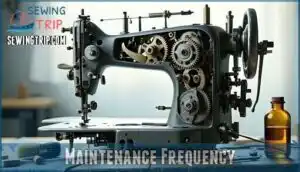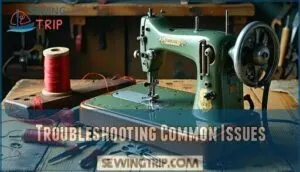This site is supported by our readers. We may earn a commission, at no cost to you, if you purchase through links.
 You’ll keep your sewing machine running smoothly by following basic sewing machine maintenance tips.
You’ll keep your sewing machine running smoothly by following basic sewing machine maintenance tips.
Regularly clean out lint and debris, oil moving parts, and store it properly.
This will extend its life and prevent issues.
By doing so, you’re taking control of your machine’s performance and safety.
Now, let’s get into the nitty-gritty of maintenance, and you’ll be sewing like a pro in no time, with a machine that’s well-oiled and ready for your next project.
Table Of Contents
Key Takeaways
- You’ll keep your sewing machine running smoothly by regularly cleaning out lint and debris, which can cause tension issues and skipped stitches, so make it a habit to clean your machine after each use.
- You should oil your machine’s moving parts to prevent rust and corrosion, and to keep it running smoothly – just remember to use the right type and amount of oil, and follow the manual’s guidelines.
- You’ll want to store your sewing machine properly when not in use, keeping it covered and unplugged to prevent damage, and regularly inspecting it for loose screws to ensure it remains in good condition.
- You can prevent common issues like skipped stitches, tension problems, and machine seizing by following a regular maintenance routine, which includes checking thread quality, needle type, and bobbin issues, and making adjustments as needed to ensure smooth operation.
Cleaning The Machine
You’ll start by cleaning the machine, which involves removing lint and debris that can build up and cause problems.
Clean your sewing machine regularly to keep it running smoothly
By following a few simple steps, you can keep your sewing machine in great condition, and it’ll continue to run smoothly, helping you create amazing projects without any hassle, ensuring your machine remains in good working order is key.
Removing Lint and Debris
You’re the master of your sewing machine’s destiny.
Lint prevention is key to a happy machine.
Regularly clean your machine to remove debris and lint buildup, which can cause tension issues and skipped stitches.
Use a nylon brush or canned air to gently remove lint, taking care not to push it deeper.
For effective cleaning, consider using compressed gas dusters to dislodge stubborn particles.
Accessing debris in tight spots requires patience and the right cleaning tools.
Post-sew cleaning is essential to prevent lint accumulation.
Remember, cleaning lint buildup is easier than fixing a damaged machine.
So, take a few minutes to clean your machine after each use, and it’ll reward you with smooth performance.
Disassembling The Machine
Before you start taking things apart, unplug your sewing machine! It’s a good safety precaution. Remove the needle, presser foot, and bobbin.
- Tool Selection: Have your screwdrivers ready.
- Manual Importance: Keep your manual nearby.
- Part Identification: Know your sewing machine parts.
Use your manual to find the screws, and gently take apart the sewing machine parts. Snap photos, so you don’t have a "where does this go?" moment later. Keep screws organized. Forcing it will cause damage, and nobody wants that! This step is essential for sewing machine cleaning and sewing machine maintenance.
Using Cleaning Supplies
You’ll need sewing machine cleaning tools, like a small lint brush or nylon brush, to clean effectively.
Choose solvent-safe products and a soft rag material for wiping.
Specialized cleaning tools, like sewing machine cleaning supplies, help tackle grease and grime.
A sewing lint brush is a great addition to your toolkit.
Work methodically, storing tools neatly, for flawless cleaning and long-lasting performance with the right sewing machine cleaning techniques.
Avoiding Damage to Moving Parts
When cleaning your sewing machine, remember that moving parts require special care. To avoid damage, follow the machine oiling guide for proper lubrication.
Handle components delicately, and remove debris thoroughly but carefully. A key step is to prevent wear and tear through regular cleaning.
- Use gentle handling to prevent scratches
- Refer to the manual for oiling points
- Avoid overuse to prevent wear
- Keep quality parts well-maintained for smooth operation.
Proper lubrication and correct alignment are key to extending your machine’s life. By following these tips, you’ll be sewing like a pro in no time, with a well-maintained machine that runs smoothly and efficiently, ensuring smooth operation and a long machine life with proper care.
Oiling The Machine
You’re now going to learn about oiling your sewing machine, a vital step in maintaining its performance.
By applying the right type and amount of oil, you’ll keep your machine’s moving parts running smoothly, and it’ll thank you with perfect stitches and a long lifespan.
Types of Oil to Use
You’ll want to choose a sewing machine oil that’s right for your machine.
Consider Synthetic vs. Mineral options, and think about oil viscosity.
Avoid harmful oils like WD-40, and opt for low-viscosity grades instead.
Many users prefer synthetic oil options for their sewing machines.
Follow manufacturer recommendations for the best sewing machine oil types and quality to keep your machine running smoothly.
Applying Oil to Moving Parts
You’re now ready to apply oil to moving parts.
- Use sewing machine oil
- Follow manual instructions
- Oil the needle bar, bobbin case, and underside for smooth sewing machine lubrication, ensuring proper sewing machine maintenance with the right oil types and oiling frequency.
Regular oiling prevents rust and corrosion and is crucial for maintaining your machine.
Avoiding Excess Oil
When oiling your sewing machine, remember less is best.
Use a drop or two of synthetic lubricant to avoid oil contamination and lint buildup.
This prevents a sticky residue from forming.
Follow the manual’s oiling frequency and diagrams to guarantee proper sewing machine maintenance and cleaning, keeping your machine running smoothly.
Checking The Manual for Oil Locations
Consult your sewing machine manual for oiling locations.
- Check diagrams
- Use proper oil
- Avoid substitutes.
Follow manual instructions to prevent damage and maintain smooth operation, using the right oil types for your specific model, and maintaining the correct oiling frequency for superior sewing machine maintenance.
Maintenance Frequency
You’ll want to establish a regular maintenance routine to keep your sewing machine running smoothly, and that starts with deciding how often to clean and oil it.
By considering your usage intensity and fabric type, you can create a schedule that works for you, whether that’s cleaning after each use or scheduling regular tune-ups.
Cleaning After Each Use
After sewing, give your machine a quick surface wipe-down.
Use brush attachments for lint disposal, especially in the bobbin area.
Here’s your checklist:
- Remove thread residue
- Clean the bobbin area
- Use a soft cloth
- Inspect for lint
- Wipe down the surface
Scheduling Regular Cleaning
You’ll want to schedule regular cleaning to keep your sewing machine in top shape.
Set a reminder to clean every 5-10 days of use or after large projects. This preventative maintenance guarantees better stitching, prevents costly repairs, and extends the machine’s life.
Think of it as self-care for your machine, paired with a cup of tea. A consistent cleaning frequency is key to stress-free projects and a well-maintained sewing machine.
So mark your calendar and get cleaning, it’s a simple step in your sewing machine maintenance schedule, ensuring a longer machine life through regular maintenance.
Considering Usage Intensity and Fabric Type
You adjust your sewing machine maintenance schedule based on fabric type and sewing intensity.
For heavy fabrics like flannel, clean more often.
Lighter fabrics or casual sewing can be monthly.
Consider needle selection and thread pairing too.
Your maintenance schedule should reflect your sewing habits for smooth sewing success.
Adjusting your schedule guarantees every stitch meets your expectations, with no hassle, making sewing machine maintenance a breeze.
To keep your machine running smoothly, remember to perform regular sewing machine lubrication.
Annual Professional Servicing
You’ll get a thorough checkup with annual professional servicing.
- Technician Specialization guarantees expertise
- Service Benefits include cost savings
- Finding Experts for sewing machine repair is key.
A professional service typically costs around $100, saving you from expensive breakdowns, and includes a detailed service checklist for your sewing machine technician, which provides cost savings and ensures that you’re working with a professional service that understands the importance of technician specialization.
Troubleshooting Common Issues
You’ll encounter issues with your sewing machine at some point, and knowing how to troubleshoot common problems is key.
By following some simple steps, you can resolve issues like skipped stitches, tension problems, and machine seizing, and get back to sewing with ease.
Skipped Stitches and Tension Problems
You’ll fix skipped stitches by checking thread quality, needle type, and bobbin issues.
Make certain the presser foot is secure, and adjust sewing machine tension in small steps.
Verify fabric feed and stitch quality, addressing thread issues and tension adjustment to prevent skipped stitches, achieving better stitch quality.
Machine Seizing and Performance Issues
If you’re having skipped stitches and tension problems, a jammed sewing machine is next-level frustrating. Don’t worry; it’s usually dust, debris, or neglect.
Avoid seizing with this checklist:
- De-lint feed dogs, bobbin, and tension discs often.
- Oil moving parts with sewing machine oil.
- Check threading to avoid jams.
- Verify smooth bobbin winding and correct placement.
Proactive sewing machine maintenance beats expensive repairs! We don’t want Motor Overheating, Bobbin Problems, Feed Dog Issues, or Thread Breaks.
Preventing Lint Buildup and Damage
You’re sewing along, when lint buildup strikes.
Certain fabrics like fleece, flannel, and minky shed fibers, clogging your machine.
Regularly inspect after every 2-3 bobbins, and use small cleaning brushes to sweep away debris.
Proper threading and needle selection are key.
Use high-quality thread to minimize lint buildup.
Clean your sewing machine frequently to prevent damage, and consider bobbin winding techniques to reduce lint.
Choose the right fabric and presser feet to make cleaning easier, and don’t forget to remove lint regularly for smooth sewing machine maintenance.
Resolving Issues With Regular Maintenance
You step up your maintenance game by catching unusual sounds or resistance early. This prevents costly repairs.
Some benefits of regular maintenance include:
- Identifying potential problems
- Addressing minor issues
- Avoiding costly repairs
- Improving stitch quality
Regular maintenance is key to preventing problems, and with consistent maintenance, you’ll enjoy better performance and fewer issues with your sewing machine.
Proper fit guarantees movement and comfort when creating garments, which is crucial for improving stitch quality.
Machine Storage and Care
You’ll want to store your sewing machine properly when not in use, keeping it covered and unplugged to prevent damage.
By doing so, you’ll avoid dust and moisture accumulation, and regularly inspecting it for loose screws will guarantee it remains in good condition.
Storing The Machine When Not in Use
When storing your machine, choose a cool, dry spot, avoiding sunlight. Humidity control is key.
Covering your machine with a breathable sewing machine cover prevents dust.
Consider optimizing your sewing room for better organization.
| Storage | Location | Tips |
|---|---|---|
| Short-term | Table | Cover machine |
| Long-term | Closet | Humidity control |
| Travel | Case | Padded protection |
| Daily | Shelf | Avoiding sunlight |
Keeping The Machine Covered and Unplugged
Now that you’ve stored your machine, keep it covered and unplugged to prevent damage.
A breathable cover shields against dust and spills.
- Use a cover made from breathable material for dust protection.
Unplug your machine after each use for safety and energy savings.
Place it in a dry, stable location, away from direct sunlight.
This protects your investment and prevents damage, aligning with key sewing machine maintenance tips, including using a sewing machine cover for dust protection and proper machine storage.
To ensure the longevity of your machine, consider these tips as part of your regular maintenance routine.
Avoiding Dust and Moisture Accumulation
To keep your sewing machine in top shape, consider its storage environment.
Use a sewing machine dust cover or breathable cloth to prevent dust buildup.
For humidity control, place desiccant packets nearby.
| Storage Tips | Benefits |
|---|---|
| Dry microfiber cloth | Dust prevention |
| Well-ventilated area | Airflow importance |
| Protective covers | Machine storage |
| Desiccant use | Humidity control |
Regular wiping and airflow importance will help maintain your machine’s perfect working condition, ensuring delicate parts are preserved with proper sewing machine cleaning and storage.
Regularly Inspecting The Machine for Loose Screws
You’ll want to regularly inspect your sewing machine for loose screws, as vibration effects can loosen parts over time.
Check screw tightness, especially on the needle plate, and use a small screwdriver to gently test each visible screw.
A dab of clear nail polish on threads can be a preventative measure, saving you sewing machine troubleshooting headaches with your maintenance checklist.
Frequently Asked Questions (FAQs)
How often should a sewing machine be maintained?
You should maintain your sewing machine every 8-10 hours of use, or after 4 bobbins, to guarantee peak performance and prevent damage.
How to maintain a sewing machine?
You’ll clean, oil, and replace needles regularly to guarantee your sewing machine runs smoothly and efficiently, preventing damage and costly repairs down the line, every 8-10 hours.
What are the essential steps in sewing machine maintenance?
You’re the maestro of your sewing machine, so tune it up by regularly changing needles, oiling, and brushing away lint to guarantee harmonious stitching and a long-lasting machine.
When should you have a professional look at your sewing machine?
You should have a professional look at your sewing machine every 2 years or annually for computerized machines, to guarantee peak performance and address any potential issues promptly.
Why do you need a sewing machine maintenance checklist?
You need a sewing machine maintenance checklist to guarantee your machine runs smoothly, prevents damage, and extends its lifespan, helping you sew efficiently and effectively every time.
Why is sewing machine maintenance important?
You’ll be sewing like crazy if you maintain your machine, preventing breakdowns, and ensuring smooth stitches, which saves time, reduces frustration, and prolongs its life.
What is the basic maintenance of a sewing machine?
You regularly clean, oil, and check your sewing machine to prevent damage and guarantee smooth operation, keeping it in great condition for years to come, every time.
What are four tips for routine care of a sewing machine?
You should clean, oil, and change needles frequently to keep your machine running smoothly, and also check tension, and disassemble for deep cleaning to prevent damage.
What is the most common sewing machine problem?
You’ll likely face thread breakage, a super frustrating issue, as the most common sewing machine problem, often due to incorrect tension or low-quality threads.
How should the sewing machine be well maintained?
You should maintain your machine by cleaning, oiling, and replacing needles regularly to prevent damage and guarantee smooth operation, following the manual’s guidelines for peak performance.
Conclusion
You’ll be sewing a million stitches with ease by following these basic sewing machine maintenance tips.
By cleaning, oiling, and storing your machine properly, you’ll extend its life and prevent issues, becoming a pro at using your well-oiled machine.
Mastering basic sewing machine maintenance tips will be a breeze, and by doing so, you’ll ensure that using your machine is easy.











